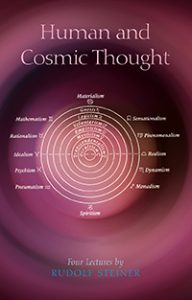Human and Cosmic Thought
Four Lectures by Rudolf Steiner, given in Berlin, January 1914.
Published by the Rudolf Steiner Press, 1961.
Reprinted in 1991, and in 2015 with a revised translation by Charles Davy.
The note at the beginning of the book regarding the need for specialized anthroposophical knowledge is discouraging for general readers. It would be better to provide Notes on the Lectures at the back of the book, clarifying certain aspects with one or two paragraphs. A note at the beginning could state that knowledge of the zodiac, the planets, and a genuine astrology will be helpful.
Lecture One is about the nature of thought and processes of thinking. “When man holds to that which he possesses in his thought, he can find an intimate relation of his being to the cosmos.” A brief history of thought is given, from the time of ancient Greece to the twentieth century. In Greece, thought took the form of pictures as a last phase of the old clairvoyance. The Middle Ages brought nominalism, which is a rejection of universal concepts. Immanuel Kant (1724-1804) tried to refute the proof of God by showing that one could not derive the existence of a thing out of a concept. Fritz Mauthner (1849-1923) cast doubt on any need for logic, as “thinking, for him, is merely speaking.” Rudolf Steiner calls for mobility in thought from a general concept using the example of a triangle. A triangle should not be thought of as a static thing but should be imagined or visualized as in continual motion, right-angled and obtuse-angled, while still a triangle. This is an example of the advance of thought from form to movement, from the realm of the Spirits of Form (the Urpflanze) to the realm of the Spirits of Movement (the Urtier).
At the beginning of Lecture Two, the need for a living grasp of what thinking involves in terms of actualities is stressed, as there are countless misunderstandings regarding the ideas people have about the world, and about one another. One man upholds certain views with many good reasons, while another has equally good reasons for his view. Rudolf Steiner begins to build what he refers to as the twelve mental zodiacal signs (Geistes-Tierkreisbilder), which are recognizable from their effects on the human soul. The mental zodiac, in the twelve shades of world-outlook, is illustrated by first placing Materialism in Cancer at the top, and its opposite sign of Spiritism in Capricorn at the bottom. A connection is then made between the two sides of the center, the 180 degree point, with a line between Idealism in Aries and Realism in Libra. Materialism extends down, on the viewers left side, to Mathematism in Gemini and Rationalism in Taurus, and then to Idealism. Beneath the central line is Psychism in Pisces and Pneumatism in Aquarius. Upward from Capricorn, on the viewers right, but still below the central line, is Monadism in Sagittarius and Dynamism in Scorpio. Above Libra at the center is Phenomenalism in Virgo and Sensationalism in Leo. The twelve world-outlooks are carefully described in the book, and there can be no more than these twelve, although variations in the outlooks can exist between the signs.
In Lecture Three, the zodiacal circle, from its center, is divided into seven outer circles and these are the paths that the seven planets and their world-outlook moods can take around the mental zodiac. The world-outlook moods are carefully described, and they are related to well-known principal attributes of the planets. They begin at the top with Gnosticism (Spirit Self) in Saturn, then Logicism (Thinking) in Jupiter, Voluntarism (Will) in Mars, Empiricism (Physical Life) in Sun, Mysticism (Feeling, Love) in Venus, Transcendentalism (Coordinative Thinking) in Mercury, and Occultism (Hidden, Etheric) in Moon. Any one of these planetary world outlook-moods can go to any one of the twelve world-outlooks in the mental zodiac, though it is difficult to imagine a Gnostic in Realism.
Rudolf Steiner adds that the world-pictures can be modified by possessing three quite different soul tones: Theism, Intuitionism, and Naturalism.
The work, therefore, toward the deeper understanding of the differences between two human beings and their philosophies can begin. For example, the differences between the Empiricist in Rationalism and the Mystic in Pneumatism, who are not likely to get along very well.
For deeper understanding of the mysterious or tragic circumstances in the biographies and works of historical figures, such as Franz Brentano (1838-1917), and Friedrich Nietzsche (1844-1900), careful study of the mental zodiac can yield valuable directions and answers.
From Lecture Four, page 60, of Human and Cosmic Thought:
“Thus… an inner conformity to law exists between the spiritual cosmos and the way in which man stands within it… In the case of Nietzsche, up to a certain time in his life Venus stood in Aries, but when for his soul this configuration passed over into ‘Sun in the sign of Taurus,’ he could get no further. He could not go with Mars into the sign of Gemini, but went into the oppositional position; thus, he went with Mars into the sign of Scorpio… But one can sustain this configuration only if one penetrates into the lower position (below the line Idealism-Realism) where one plunges into a spiritual world-outlook, Occultism or something similar; otherwise these configurations must work back unfavorably upon the person himself. Hence the tragic fate of Nietzsche.” – Review by Martha Keltz

